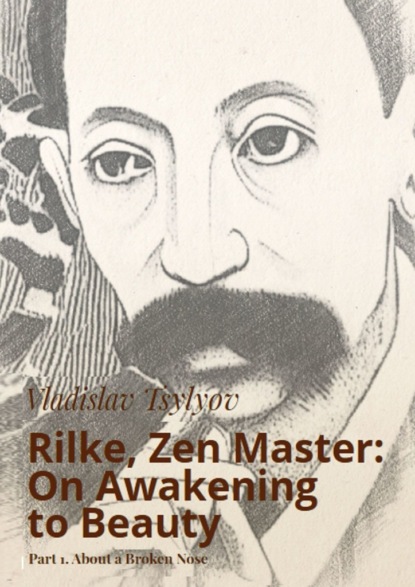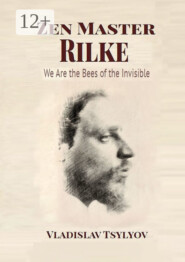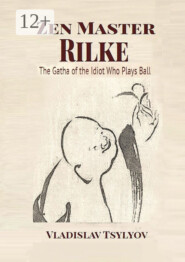По всем вопросам обращайтесь на: info@litportal.ru
(©) 2003-2024.
✖
Rilke, Zen Master: On Awakening to Beauty. Part 1. About a Broken Nose
Настройки чтения
Размер шрифта
Высота строк
Поля
Rilke, Zen Master: On Awakening to Beauty. Part 1. About a Broken Nose
Vladislav Tsylyov
In this fantasy book, the outstanding twentieth-century poet R. M. Rilke (1875—1926) speaks with enlightened masters of non-doing about the most intimate thing, beauty. On the one hand, there are allusions to the Platform Sutra of the Sixth Patriarch Hui Neng and the Records of the Teacher Linji; on the other, there are Rilke’s own works: koan-like poems on Buddha and a few others (from the New Poems), fragments of the poet’s essay on the sculptor Auguste Rodin and extracts from his letters.
Rilke, Zen Master: On Awakening to Beauty
Part 1. About a Broken Nose
Vladislav Tsylyov
Translator Vladislav Tsylyov
Illustrator Vladislav Tsylyov
Cover designer Vladislav Tsylyov
© Vladislav Tsylyov, 2023
© Vladislav Tsylyov, translation, 2023
© Vladislav Tsylyov, illustrations, 2023
© Vladislav Tsylyov, cover design, 2023
ISBN 978-5-0062-0349-5 (т. 1)
ISBN 978-5-0062-0350-1
Created with Ridero smart publishing system
Zen Master Rilke
A Brief Appeal To the Reader
I must admit that I have tried very hard to organise and polish this book to an appropriate level of rigour, but it has still come out as quirky as a chaotic kaleidoscope. Nevertheless, I hope that even a cursory glance at the contents of the book will be enough to surprise the reader who is familiar with Rilke’s work, at least a little, and to raise natural questions: ́So what is the connection between Buddha and Rilke? And what can an early twentieth-century European modernist poet and an Eastern patriarch of non-action, who lived in the far seventh century, discuss for so long and so enthusiastically? And finally, what is the role of this strange head with the broken nose?́
As for myself, I still haven’t found an answer to any of these rather fair questions. Although, as the author of this book, I’m supposed to have found them. Otherwise, what would be the point of writing it? The only thing that excuses me is that I have tried to find the answers in the pages of this work, albeit with naive hope: first in the pathetic introduction on beauty, written, of course, on the basis of my own self-confident ideas. And then in the main text, in the dialogues which, although imaginary, involve historical characters with their authentic rather than fictional voices.
In order to finally arouse the reader’s interest in this book, I would like to assure him that it is not only the head of the old man with the broken nose that will be found in its pages. There is, of course, something more fascinating. A very rare and exotic butterfly, for example. A Chan butterfly of enlightenment. It is said that if it flutters even for a moment in front of the astonished reader, the primordial beauty will instantly reveal its true face to the viewer. And that will be the beauty that shines with its own light.
Gioconda with the smile of Nirvana.
…and Some Important Things To Know About the Book
First of all, I would like to emphasise that the title of my author’s Buddha-Rilke series in no way implies that Rilke was a follower of Gautama Buddha, or that his lyrical revelations should in the least be taken as such. It is well known that the poet categorically rejected all teachings. But his vision as a creator and artist was so multifaceted that it is not difficult to discern features of the most diverse philosophical conceptions in it.
Nor should the reader expect me to expound Buddhist doctrine: I have approached the philosophical literary sources of the Chan school primarily as artistic texts.
I would also like to draw the reader’s attention to the fact that, as he gets to know the book, he will find in it six remarkable poems by Rilke from his New Poems: ́The Swań, ́St Sebastiań, ́Buddhá in two versions, ́The Scarab́ and ́Buddha in Glorý; as well as the Ninth Sonnet from the Sonnets to Orpheus. All the poems above are given as my free prose translations, without regard to the rhyme and rhythm of the quoted original.
As for the dialogues presented in the book, they are all figments of my imagination, with a slight ́Buddhist́ tendency. It should also be said that all the characters’ speeches and all the phrases in the epigraphs represent a wide range of my own readings, from ́free flight́ to exact translation, except in the case of a few literal quotations, which are accompanied by obligatory references not only to the authors but also to the sources.
As soon as the reader begins to turn the pages of the Dialogues, he or she will immediately notice that R. M. Rilke himself is represented in the poet’s image. The textual material for the poet’s statements has been taken from Rilke’s famous essay Auguste Rodin, as well as from several of his letters, fragments of which I have attempted to translate accurately, while allowing for selective editing to ensure the semantic unity of the Dialogues. Such ́extraneouśinsertions are indicated by square brackets.
The image of the Patriarch is a collective one and mainly implies historical figures such as Hui Neng and Linji, the legendary masters of the Chan school. It should be noted that the Patriarch’s sayings are mostly my fantasies and arrangements, composed on motives of sermons and instructions not only of the mentioned great teachers, but also of such famous Chan (or Zen) masters as Sengcan (496? -606), Shih Wang Ming (6th century), Ummon (864 -949), and Hakuin (1686—1769).
The book contains a large number of illustrations, both my own and based on public domain images. The latter include works by such prominent Zen artists as Liang Kai (c. 1140—1220) and Hakuin Ekaku (1686—1769), as well as the lesser known but very ́expressivé master Shi Ke (mid-tenth century).
Finally, I would like to express my deep gratitude to a very special mentor and person, Master Tho Idi, for his invaluable moral support, without which this literary experiment could hardly have taken place. And although Master Tho Idi seems to exist… only in my imagination, i.e. he is a fictional character in this book, I hope that this kind of gratitude on my part will not surprise the reader who is ready for ́surpriseś.
After all, the reader is offered a strange book… with a touch of Chan.
A Few Words On Beauty for which there is and can be no cause other than itself
Beauty precedes God.
– Master Tho Idi
Two Masters of Zen
A Paradoxical Meeting
And now it is time to return to our main characters, Gautama Buddha and Rilke, and ask ourselves again: ́Is there really anything that unites these two names? Isn’t such a ́rapprochement́ just a spectacular play on words, an extravagant fantasy of the author?́
Really, putting them together feels rather artificial at first, but then, as you delve into the ́themé, something unexpected emerges between them that is worth thinking about, and eventually it becomes something exciting and grandiose that takes your breath away. For behind each of these names lies a universe of insight. All the more surprising when they
come together!
This book is an attempt to capture the vastness of that encounter. The author spent a long time working on the idea for this book, essentially asking himself a single question: ́What is the mysterious and omnipresent force that spiritualises these two such different names? What is the universal law that unites them?́ And at one point he even gave up the idea, realising his utter helplessness… Until one day ́enlightenment́ came upon him and he heard a single word, as simple and clear as God’s day:
Beauty!
An inviolable principle
Surely someone will find such a ́glimpsé of thought deliberately far-fetched, or even trivial. For ́beautý is a lofty and all too tempting word. Especially as the sacramental immediately comes to mind:
Beauty will save the world.
It would seem that the great Russian novelist had already established beauty as an immutable moral principle. Is there really anything to add to these winged words? The author of this book is convinced that there is, and from an unexpected angle: it turns out that Fyodor Mikhailovich’s aphorism also has a hint of Buddhist meaning. It is hard to resist paraphrasing the Buddha:
Beauty is Truth! Beauty is the sacred Law! Beauty is the Teachings!
Two Masters of Zen
And it is hard to avoid giving Dostoyevsky’s visionary statement a new sound:
Beauty in itself brings us freedom from delusion, suffering and death!
If the reader is still in doubt, the words of the teacher Tho Idi will clarify the meaning of the above:
Vladislav Tsylyov
In this fantasy book, the outstanding twentieth-century poet R. M. Rilke (1875—1926) speaks with enlightened masters of non-doing about the most intimate thing, beauty. On the one hand, there are allusions to the Platform Sutra of the Sixth Patriarch Hui Neng and the Records of the Teacher Linji; on the other, there are Rilke’s own works: koan-like poems on Buddha and a few others (from the New Poems), fragments of the poet’s essay on the sculptor Auguste Rodin and extracts from his letters.
Rilke, Zen Master: On Awakening to Beauty
Part 1. About a Broken Nose
Vladislav Tsylyov
Translator Vladislav Tsylyov
Illustrator Vladislav Tsylyov
Cover designer Vladislav Tsylyov
© Vladislav Tsylyov, 2023
© Vladislav Tsylyov, translation, 2023
© Vladislav Tsylyov, illustrations, 2023
© Vladislav Tsylyov, cover design, 2023
ISBN 978-5-0062-0349-5 (т. 1)
ISBN 978-5-0062-0350-1
Created with Ridero smart publishing system
Zen Master Rilke
A Brief Appeal To the Reader
I must admit that I have tried very hard to organise and polish this book to an appropriate level of rigour, but it has still come out as quirky as a chaotic kaleidoscope. Nevertheless, I hope that even a cursory glance at the contents of the book will be enough to surprise the reader who is familiar with Rilke’s work, at least a little, and to raise natural questions: ́So what is the connection between Buddha and Rilke? And what can an early twentieth-century European modernist poet and an Eastern patriarch of non-action, who lived in the far seventh century, discuss for so long and so enthusiastically? And finally, what is the role of this strange head with the broken nose?́
As for myself, I still haven’t found an answer to any of these rather fair questions. Although, as the author of this book, I’m supposed to have found them. Otherwise, what would be the point of writing it? The only thing that excuses me is that I have tried to find the answers in the pages of this work, albeit with naive hope: first in the pathetic introduction on beauty, written, of course, on the basis of my own self-confident ideas. And then in the main text, in the dialogues which, although imaginary, involve historical characters with their authentic rather than fictional voices.
In order to finally arouse the reader’s interest in this book, I would like to assure him that it is not only the head of the old man with the broken nose that will be found in its pages. There is, of course, something more fascinating. A very rare and exotic butterfly, for example. A Chan butterfly of enlightenment. It is said that if it flutters even for a moment in front of the astonished reader, the primordial beauty will instantly reveal its true face to the viewer. And that will be the beauty that shines with its own light.
Gioconda with the smile of Nirvana.
…and Some Important Things To Know About the Book
First of all, I would like to emphasise that the title of my author’s Buddha-Rilke series in no way implies that Rilke was a follower of Gautama Buddha, or that his lyrical revelations should in the least be taken as such. It is well known that the poet categorically rejected all teachings. But his vision as a creator and artist was so multifaceted that it is not difficult to discern features of the most diverse philosophical conceptions in it.
Nor should the reader expect me to expound Buddhist doctrine: I have approached the philosophical literary sources of the Chan school primarily as artistic texts.
I would also like to draw the reader’s attention to the fact that, as he gets to know the book, he will find in it six remarkable poems by Rilke from his New Poems: ́The Swań, ́St Sebastiań, ́Buddhá in two versions, ́The Scarab́ and ́Buddha in Glorý; as well as the Ninth Sonnet from the Sonnets to Orpheus. All the poems above are given as my free prose translations, without regard to the rhyme and rhythm of the quoted original.
As for the dialogues presented in the book, they are all figments of my imagination, with a slight ́Buddhist́ tendency. It should also be said that all the characters’ speeches and all the phrases in the epigraphs represent a wide range of my own readings, from ́free flight́ to exact translation, except in the case of a few literal quotations, which are accompanied by obligatory references not only to the authors but also to the sources.
As soon as the reader begins to turn the pages of the Dialogues, he or she will immediately notice that R. M. Rilke himself is represented in the poet’s image. The textual material for the poet’s statements has been taken from Rilke’s famous essay Auguste Rodin, as well as from several of his letters, fragments of which I have attempted to translate accurately, while allowing for selective editing to ensure the semantic unity of the Dialogues. Such ́extraneouśinsertions are indicated by square brackets.
The image of the Patriarch is a collective one and mainly implies historical figures such as Hui Neng and Linji, the legendary masters of the Chan school. It should be noted that the Patriarch’s sayings are mostly my fantasies and arrangements, composed on motives of sermons and instructions not only of the mentioned great teachers, but also of such famous Chan (or Zen) masters as Sengcan (496? -606), Shih Wang Ming (6th century), Ummon (864 -949), and Hakuin (1686—1769).
The book contains a large number of illustrations, both my own and based on public domain images. The latter include works by such prominent Zen artists as Liang Kai (c. 1140—1220) and Hakuin Ekaku (1686—1769), as well as the lesser known but very ́expressivé master Shi Ke (mid-tenth century).
Finally, I would like to express my deep gratitude to a very special mentor and person, Master Tho Idi, for his invaluable moral support, without which this literary experiment could hardly have taken place. And although Master Tho Idi seems to exist… only in my imagination, i.e. he is a fictional character in this book, I hope that this kind of gratitude on my part will not surprise the reader who is ready for ́surpriseś.
After all, the reader is offered a strange book… with a touch of Chan.
A Few Words On Beauty for which there is and can be no cause other than itself
Beauty precedes God.
– Master Tho Idi
Two Masters of Zen
A Paradoxical Meeting
And now it is time to return to our main characters, Gautama Buddha and Rilke, and ask ourselves again: ́Is there really anything that unites these two names? Isn’t such a ́rapprochement́ just a spectacular play on words, an extravagant fantasy of the author?́
Really, putting them together feels rather artificial at first, but then, as you delve into the ́themé, something unexpected emerges between them that is worth thinking about, and eventually it becomes something exciting and grandiose that takes your breath away. For behind each of these names lies a universe of insight. All the more surprising when they
come together!
This book is an attempt to capture the vastness of that encounter. The author spent a long time working on the idea for this book, essentially asking himself a single question: ́What is the mysterious and omnipresent force that spiritualises these two such different names? What is the universal law that unites them?́ And at one point he even gave up the idea, realising his utter helplessness… Until one day ́enlightenment́ came upon him and he heard a single word, as simple and clear as God’s day:
Beauty!
An inviolable principle
Surely someone will find such a ́glimpsé of thought deliberately far-fetched, or even trivial. For ́beautý is a lofty and all too tempting word. Especially as the sacramental immediately comes to mind:
Beauty will save the world.
It would seem that the great Russian novelist had already established beauty as an immutable moral principle. Is there really anything to add to these winged words? The author of this book is convinced that there is, and from an unexpected angle: it turns out that Fyodor Mikhailovich’s aphorism also has a hint of Buddhist meaning. It is hard to resist paraphrasing the Buddha:
Beauty is Truth! Beauty is the sacred Law! Beauty is the Teachings!
Two Masters of Zen
And it is hard to avoid giving Dostoyevsky’s visionary statement a new sound:
Beauty in itself brings us freedom from delusion, suffering and death!
If the reader is still in doubt, the words of the teacher Tho Idi will clarify the meaning of the above:








